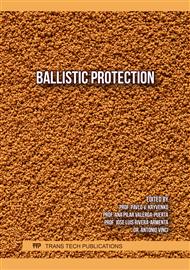[1]
W Liu, J Yang. Current statuw and development of atmor protective material. Materials &Heat Treatment, 2011, 40(2): 108-111(In Chinese).
Google Scholar
[2]
J R Hu, C H Tao, G H Wu. Research Progress of Armor-piercing Damage of Alloys. Failure Analysis and Prevention, 2017, 12(6): 392-397(In Chinese).
Google Scholar
[3]
Bartus S D.Evaluation of titanium-5Al-5Mo-5V-3Cr alloy against fragment and armor-piercing projectiles. U.S. Army, Research Laborarory, 2009: 1-99.
DOI: 10.21236/ada516831
Google Scholar
[4]
Singh B B, Sukumar G, Bhattacharjee A, et al. Effect of heat treatment on ballistic impact behavior of Ti-6Al-4V against 7.62 mm deformable projectile. Materials and Design, 2012, 36:640-649.
DOI: 10.1016/j.matdes.2011.11.030
Google Scholar
[5]
C Zheng, F C Wang, X W Cheng,et al. Effect of microstructures on ballistic impact property of Ti-6Al-4V targets. Materials Science and Engineering A, 2014, 608 (7): 53-62.
DOI: 10.1016/j.msea.2014.04.032
Google Scholar
[6]
Crowley G. How to extract low cost titanium. Advanced Materials & Processes, 2003, 11: 25-27.
Google Scholar
[7]
J Y Wang, Z M Ge, Y B Zhou. Aeronautical titanium alloy [M]. Shanghai: Shanghai science and technology Press, 1985 (In Chinese).
Google Scholar
[8]
X Y Zhang, Y Q Zhao, C G Bai. Titanium Alloy and its application. Beijing: Chemical Industry Press, 2004(In Chinese).
Google Scholar
[9]
Z S Zhu. Research and Development of New-brand Titanium Alloys of High Performance forAeronautical Application. Aviation Industry Press, 2013.12 (in Chinese).
Google Scholar
[10]
Nilesh P. Gurao, Ashkar Ali A, Satyam Suwas: Materials Science and Engineering A Vol. 504(2009), pp.24-35.
Google Scholar
[11]
Y Y Fu, Y Q Song, S X Hui, X J Mi, Research and Application of Typical Aerospace Titanium Alloys, Chinese of Rare Metals 30 (2006) 850-856.
Google Scholar
[12]
Z S Zhu, X N Wang, G Q Shang, et al., Research and development of damage tolerance alloys for aeronautical use in China, The 12th World Conference on Titanium, Beijing, (2011).
Google Scholar
[13]
Editorial Board of China aeronautical materials handbook. China aeronautical materials handbook (Second Edition)[M], Beijing: China standard press, 2001 (in Chinese).
Google Scholar
[14]
J H Qian. Application and Development of New Titanium Alloys for Aerospace, Chinese of Rare Metals 24 (2000) 218-223.
Google Scholar
[15]
B Y Huang, C G Li, L K Shi, et al. China materials engineering manual (volume 4)[M]. Beijing: China Materials Engineering Canon, 2005 (in Chinese).
Google Scholar
[16]
Smith J O.The effect of range of stress on the fatigue strength of metals. University of Illinois at Urbana-Champaign, College of Engineering Experiment Station, 192, 26: 19-27.
Google Scholar



